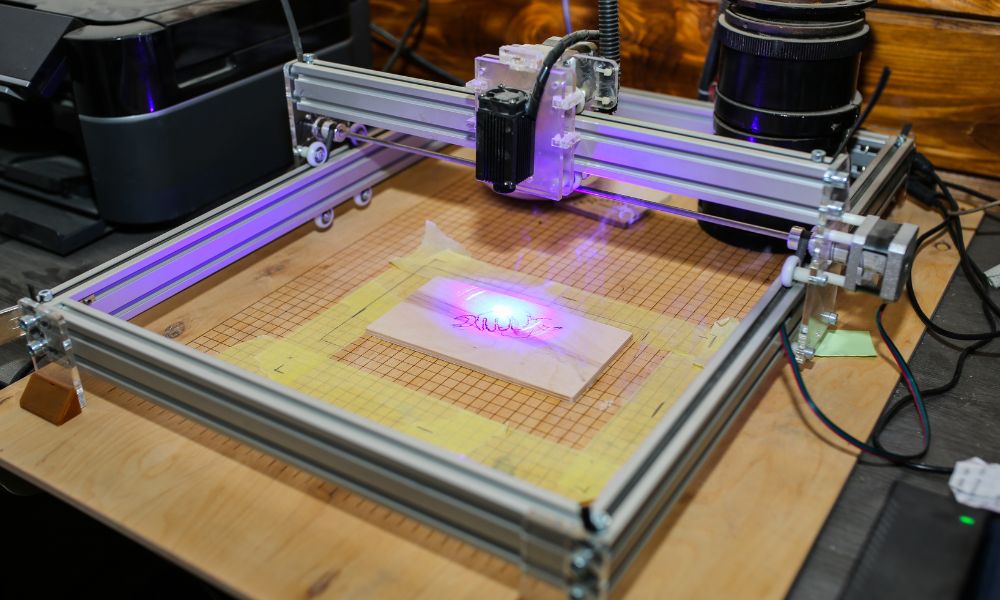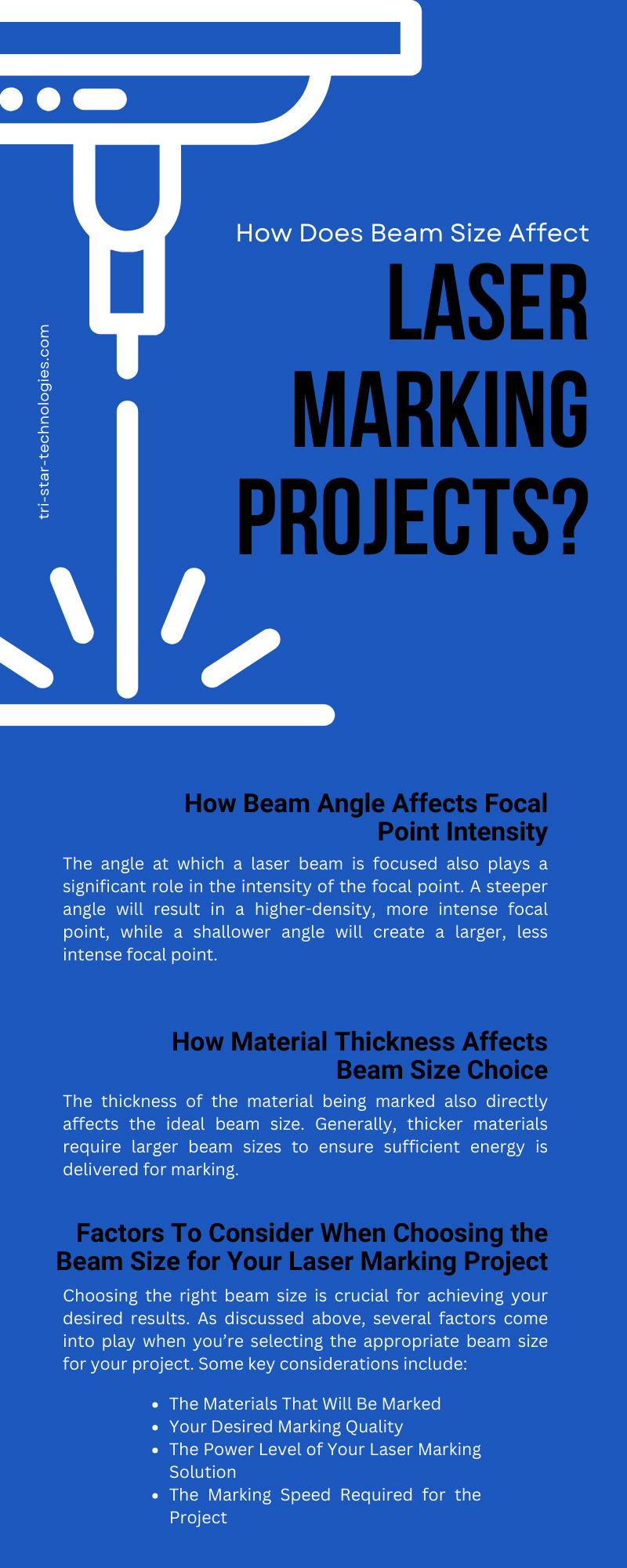How Does Beam Size Affect Laser Marking Projects?

Beam size is one often-overlooked factor that has a major effect on the overall outcome of a laser marking project. Understanding how beam size affects laser marking projects can significantly affect the quality, speed, and cost of the final result. If you want to learn more about the relationship between laser marking and beam size, Tri-Star Technologies has you covered. Keep reading to understand how beam size and other factors influence laser marking quality, from beam angle to focal point intensity.
Defining Beam Size and its Significance
Beam size refers to the diameter of the focused laser beam used in marking. Beam size is crucial, as it determines the mark depth, marking speed, and level of detail that can be achieved. Some of the most common beam sizes include:
Small beams: Typically focus down to about 20 microns
Medium beams: Focus down to about 50 microns
Large beams: Focus down to around 100 microns or larger
How Beam Angle Affects Focal Point Intensity
The angle at which a laser beam is focused also plays a significant role in the intensity of the focal point. A steeper angle will result in a higher-density, more intense focal point, while a shallower angle will create a larger, less intense focal point. This means that a smaller beam angle is ideal for projects requiring high precision and detail. On the other hand, projects that prioritize speed and coverage would benefit from a larger beam angle. Considering the desired outcome of your project when you’re choosing the appropriate beam angle is essential.
How Material Thickness Affects Beam Size Choice
The thickness of the material being marked also directly affects the ideal beam size. Generally, thicker materials require larger beam sizes to ensure sufficient energy is delivered for marking. This is because the laser loses intensity due to absorption and scattering as it travels through the material, thus requiring more power and a larger focal point for effective marking.
Common Applications for Various Beam Sizes
Small beam sizes are ideal for intricate and delicate markings in medical devices, electronics, and jewelry. Medium beam sizes balance precision and speed, making them suitable for automotive part marking and consumer goods labeling. Large beam sizes are often used for industrial applications such as metal part marking and deep carving.
Factors To Consider When Choosing the Beam Size for Your Laser Marking Project
Choosing the right beam size is crucial for achieving your desired results. As discussed above, several factors come into play when you’re selecting the appropriate beam size for your project. Some key considerations include:
The Materials That Will Be Marked
Before you select a beam size, you must understand the materials that will be marked. Different materials have varying absorption and scattering properties, which can affect the intensity of the laser beam and, therefore, the ideal beam size. For example, metals generally require larger beams due to their high reflectivity, while plastics may need smaller beams for precise markings.
Your Desired Marking Quality
When you’re choosing a beam size, considering the desired marking quality for your project is essential. Smaller beams are more suitable for projects that need high levels of precision and detail. However, if speed and coverage are your top priorities, a larger beam may be the best option.
The Power Level of Your Laser Marking Solution
The power level of your laser marking solution is another crucial factor to consider when you’re deciding on the appropriate beam size. A higher-powered laser will require a larger beam size to deliver enough energy for effective marking, while a lower-powered laser may be more suitable for smaller beam sizes. Ensuring your chosen beam size aligns with your laser marking machine’s capabilities and power level is important.
The Marking Speed Required for the Project
Another factor to consider when you’re selecting a beam size is the marking speed required for your project. Larger beam sizes tend to cover more surface area, resulting in faster marking times. This makes them ideal for projects that prioritize speed and efficiency. On the other hand, smaller beam sizes are better suited for intricate, detailed markings that require slower, more precise movements.
Advantages of Smaller Beam Sizes for Laser Marking Projects
Improved Accuracy
Smaller beam sizes offer higher precision and accuracy in laser marking projects. This is due to the smaller focal point size, which allows for finer details and more intricate markings. Additionally, smaller beams are less likely to cause thermal damage or distort the marked material, resulting in cleaner, more accurate markings.
Higher Cost-Effectiveness
Smaller beam sizes can also offer cost-saving advantages for laser marking projects. As they require less energy, smaller beams can result in lower operating costs and more efficient use of materials. This is especially beneficial for high-volume marking projects, where even slight savings in cost per unit can make a significant difference.
Reduced Heat Buildup
In some instances, larger beam sizes can result in excessive heat buildup, which can damage the material being marked and affect the quality of the final result. Smaller beam sizes reduce this risk by delivering less energy and generating less heat during the marking process.
Advantages of Larger Beam Sizes for Laser Marking Projects
Faster Workflow
One of the most significant advantages of using larger beam sizes for laser marking projects is their ability to cover more surface area more quickly. This makes them ideal for large-scale industrial applications, where speed and efficiency are essential.
Improved Depth Control
Larger beams also offer improved depth control during the laser marking process. This allows for deeper markings on thicker materials without sacrificing accuracy or speed. Considering the desired mark depth is crucial when you’re choosing a beam size for your project.
Reduced Total Cost of Ownership (TCO)
Smaller beam sizes may offer cost-saving benefits in terms of energy consumption, but larger beam sizes can result in a lower TCO over time. This is due to their ability to handle high-volume marking projects more quickly, resulting in higher productivity and efficiency.
Find the Ideal Laser Marking Solution for Your Project at Tri-Star Technologies
We hope that our guide has explained how beam size affects laser marking projects and that it can help you choose your project’s ideal laser beam size. Whether you require a small, medium, or large beam size for your laser marking project, Tri-Star Technologies provides top-tier laser marking systems tailored to meet your industry’s unique demands. Feel free to contact our team if you have any questions or need further guidance in choosing the perfect laser marking solution for your specific requirements.



